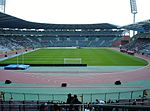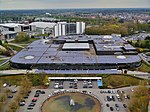Mini-Europe

Mini-Europe is a miniature park located in Bruparck, at the foot of the Atomium, in Brussels, Belgium. Mini-Europe has reproductions of monuments in the European Union and other countries within the continent of Europe on display, at a scale of 1:25. Roughly 80 cities and 350 buildings are represented. Mini-Europe receives 350,000 visitors per year and has a turnover of €4 million.The park contains live action models such as trains, mills, an erupting Mount Vesuvius, and cable cars. A guide gives the details on all the monuments. At the end of the visit, the Spirit of Europe exhibition gives an interactive overview of the European Union in the form of multimedia games. The park is built on an area of 24,000 m2 (300,000 sq ft). The initial investment was of €10 million in 1989, on its inauguration by then-Prince Philip of Belgium.
Excerpt from the Wikipedia article Mini-Europe (License: CC BY-SA 3.0, Authors, Images).Mini-Europe
Avenue du Football - Voetballaan, City of Brussels
Geographical coordinates (GPS) Address Phone number Website Nearby Places Show on map
Geographical coordinates (GPS)
| Latitude | Longitude |
|---|---|
| N 50.894 ° | E 4.339 ° |
Address
Mini-Europe
Avenue du Football - Voetballaan 1
1020 City of Brussels
Belgium
Open on Google Maps









